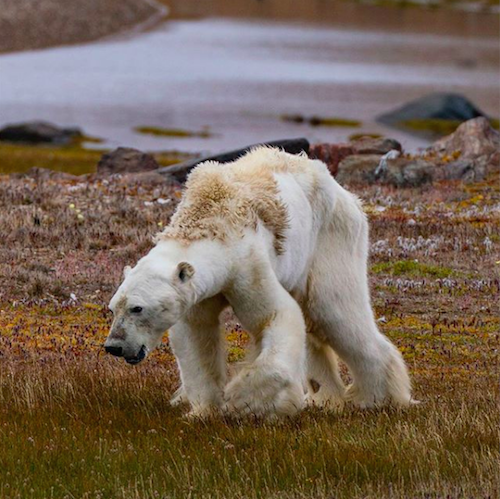Video of wild polar bear starving to death is both heartbreaking and a stirring call to action.
The footage, captured by photographer Paul Nicklen of the conservation group Sea Legacy, shows a young, male polar bear hopelessly dragging itself across a dry Baffin Island in the Canadian north in search of food.
The bear was photographed in August at an abandoned Inuit camp as it looked through an old garbage bin.
The bear finds nothing. Then, he slumps down helplessly.
“My entire @Sea_Legacy team was pushing through their tears and emotions while documenting this dying polar bear,” Nicklen writes in his Instagram post, which quickly amassed more than 1 million views in just a few days.
“It’s a soul-crushing scene that still haunts me,” he adds, “but I know we need to share both the beautiful and the heartbreaking if we are going to break down the walls of apathy. This is what starvation looks like. The muscles atrophy. No energy. It’s a slow, painful death. When scientists say polar bears will be extinct in the next 100 years, I think of the global population of 25,000 bears dying in this manner.”
Warning: This is incredibly hard, but important to watch.
The scene is gutting, but it should give people pause.
This is what climate change does.
“There was no saving this individual bear,” Nicklen adds. “People think that we can put platforms in the ocean or we can feed the odd starving bear. The simple truth is this—if the Earth continues to warm, we will lose bears and entire polar ecosystems. This large male bear was not old, and he certainly died within hours or days of this moment. But there are solutions. We must reduce our carbon footprint, eat the right food, stop cutting down our forests, and begin putting the Earth—our home—first.”
As Sea Legacy points out this bear was beyond saving.
“Many of you have asked whether we could have saved this individual bear, but the hard truth is that he was on his last legs and his muscles had atrophied beyond repair,” the group notes. “It would also have been illegal to feed him, to approach him, or to do anything to ease his pain.”
Photographer Cristina Mittermeier, who is also a co-founder of Sea Legacy, says her heart breaks when she looks at this photo she snapped.
“We cried as we filmed this dying bear,” she writes. “This is the face of climate change. A polar bear struggles to stand in his final days on the planet. We traveled to the Arctic with @sea_legacy in August and saw both healthy bears and starving bears. As climate change accelerates, we will see less of the former and more of the latter. It’s a heartbreaking reality of our current lifestyle.”
But they aren’t giving up.
And say neither should we.
Main photo Cristina Mittermeier/Instagram





Comments